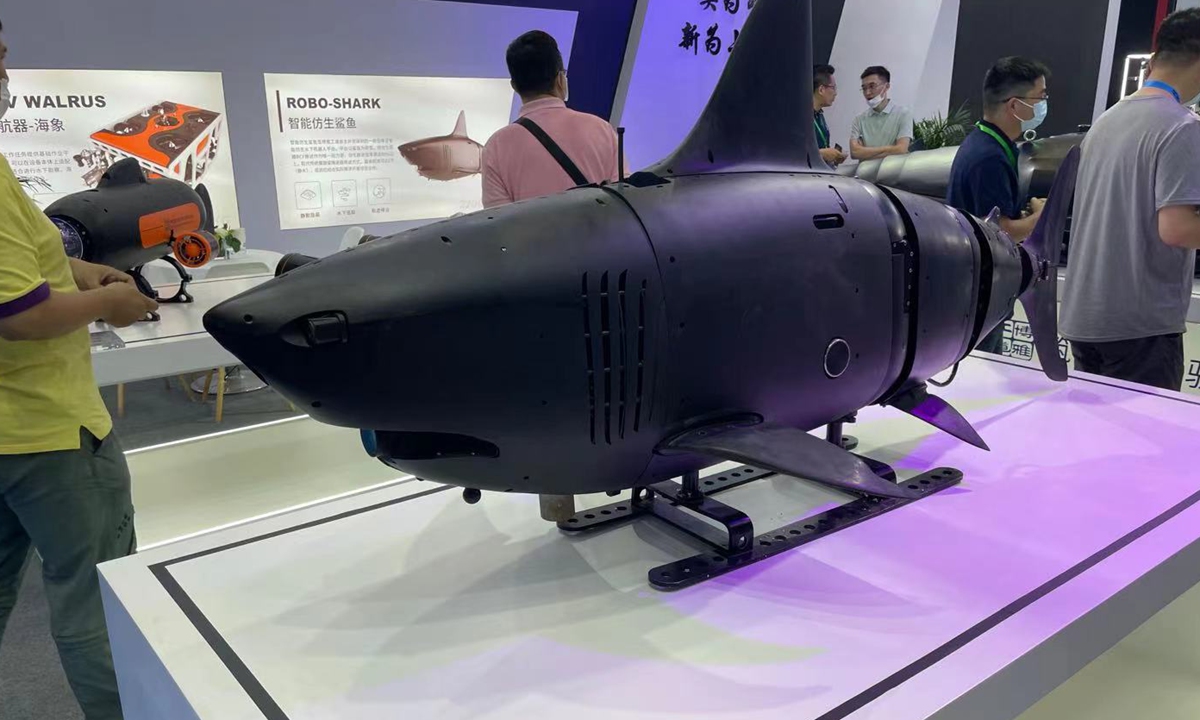China recently showcased its future unmanned military arsenal at an expo in Beijing. A number of military robots including the underwater drone – ‘Robo-Shark’ were on display.
How this undersea drone will fare against the US ‘Snakehead’ if a conflict breaks out in the troubled waters of the South China Sea or in the Taiwan Strait?
The Robo-Shark has been developed by Beijing-based Gongdao Robot Technology. The undersea drone, resembling a shark, has features such as “low noise, long-endurance, fast speed, and high flexibility”, China’s state-owned The Global Times reported.
The Chinese Robo-Shark
The Robo-Shark is equipped with a bionic tailfin, in place of a traditional propeller, which enables the underwater robot to move at a maximum speed of approximately six knots.
It is capable of conducting underwater reconnaissance, search and rescue operations, anti-submarine operations, hydrological surveys, relay communication, and tracking operations.
https://twitter.com/XHNews/status/1302522504045424640
The Robo-Shark is being used by the Chinese military on a critical project, the report stated. Like a real shark, it is able to operate with a low acoustic signature at high speeds.
This development assumes significance as China recently declassified a report on its deployment of a submarine drone in the Taiwan Strait 10 years back. It is believed China’s PLA Navy has been enhancing its unmanned undersea capabilities, closing in, and giving the US a stiff challenge in the field.

China’s Undersea Drones
In 2020, Forbes reported that China had deployed a fleet of its unmanned underwater vehicle (UUV) – the Sea Wing — in the Indian Ocean in December 2019. According to the report, 12 Sea Wing gliders were launched to conduct a survey for the Chinese Ministry of Natural Resources.
The Sea Wing, also known as Haiyi, is believed to be unpowered and runs on variable-buoyancy propulsion, enabling the vehicle to sink and then subsequently rise to the water surface again. The vehicle has large wings, which help it to glide forward easily, operating for longer durations and covering vast distances.
The features make the Sea Wing perfect for long-duration operations, in which the vehicle can be deployed and retrieved at a later time, after the completion of the mission.
https://twitter.com/detresfa_/status/1344149935734673410
The Sea Wing can gather data, such as seawater temperature, salinity, turbidity, and oxygen levels. The aerial fixed in the tail of the vehicle relays the information gathered to the mothership.
The recently declassified report reveals details about a project funded by the Chinese military, under which drones, which could identify, track and attack an enemy submarine, without any human interference, were built, as The EurAsian Time had reported.
Indian Army Pushes Govt On ‘Urgent’ Acquisition Of Russian Ka-226 Helicopters
While no specific location or route of the unmanned submarine was provided in the report, through the coordinates in the maps, it can be ascertained that the underwater vehicle was deployed near the coast of Fujian province of China or along the Taiwan Strait.
The US ‘Snakehead’
The US Navy is set to acquire unmanned undersea vehicles, under its Snakehead program. These drones will be launched by nuclear-powered submarines, to track certain underwater areas and gather intelligence.
According to the US Navy, the Snakehead, also called Large Displacement Unmanned Undersea Vehicle (LDUUV) program, is a “long-endurance, multi-mission UUV, deployed from submarine large open interfaces, with the capability to deploy reconfigurable payloads.”
“It is the largest UUV intended for hosting and deployment from submarines and has been designated a Maritime Accelerated Acquisition,” the Navy said in a statement issued on December 23, 2020.
It is expected that the first such drones will be designed to support Intelligence Preparation of the Operating Environment (IPOE) missions, while the vehicles may later be used in missions of different payloads.
The Snakehead will also help the US Navy in various intelligence, surveillance and reconnaissance (ISR) missions.
The Snakehead program is expected to enhance the US electronic warfare capability. It will be equipped with an electronic support measures (ESM) system which will enable it to gather information from enemy radars and communication nodes.
In 2020, the US Navy inducted Raytheon’s Barracuda, which is capable of tracking as well as destroying mines, without any human intervention.
The Raytheon AN/AQS-20 C mine hunting sonar system is equipped with five sensors enabling the vehicle with a high degree of acoustic identification. The system can detect, classify and identify mines on the sea bed, reported Naval News.
‘Detective Iver’
Last year, the US used the Iver 3-series type drones to conduct bilateral drills with Sweden, including the deployment and recovery of unmanned water vehicles by the US, reported The EurAsian Times.
Citing US naval sources, it was reported that underwater drones, such as the Ivers can be deployed in areas where the location and composition of hostile platforms may not be known.
The Iver 3-series can be deployed to perform various tasks such as sensor development, surveys, sub-surface security and research. The system is reportedly 74-85 inches long and weighs approximately 38.5 kg. Its maximum speed is around 4 knots and has an endurance of around 8-14 hours at a speed of 2.5 knots.
These undersea drones can relay information such as the presence of mines, or other obstacles which may hinder navigation.
The information relayed by the undersea drones can help the naval operators, in various operations, ranging from infiltration in a particular area, by a small watercraft or undersea operations by miniature submarines or by the use of personal diving equipment.
Read More
- Watch: The Ultimate Dogfight Between US & Russian Fighter Jets Over A ‘Top-Secret’ Air Base In Nevada
- Why India’s Ladakh Region Is Crucial For China’s Rise As An Economic Super-Power?